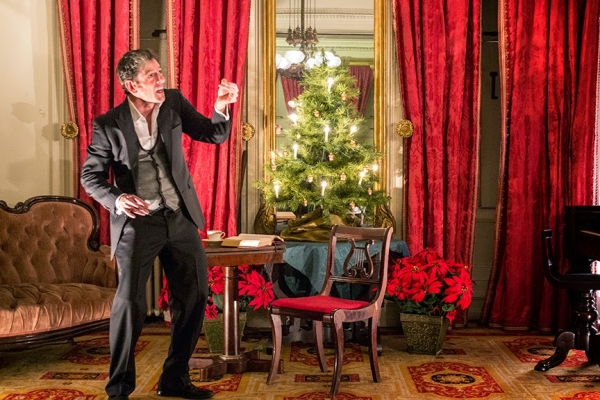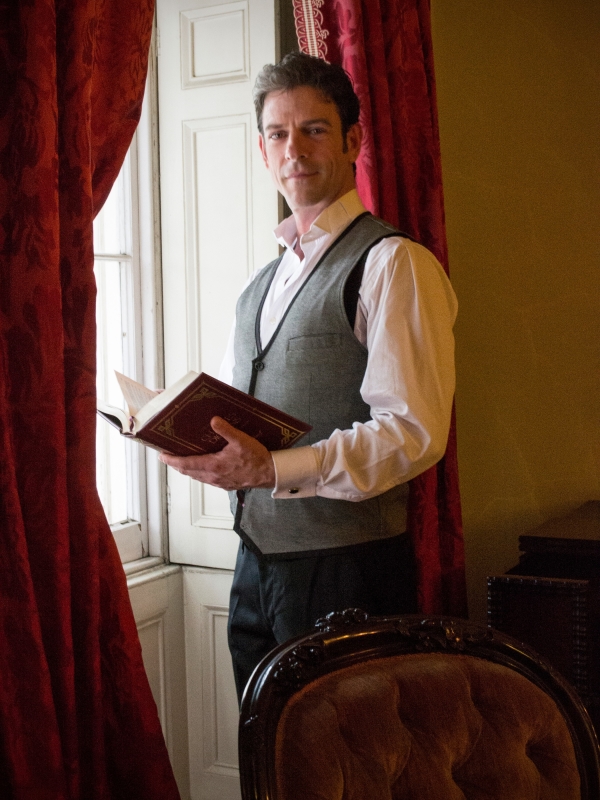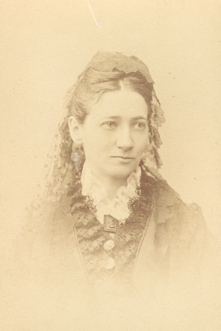The Ghosts of Christmas Past, Present, and Future Visit a Real Haunted House in Manhattan
John Kevin Jones of Summoners Ensemble Theatre talks about his solo version of Charles Dickens’ ”A Christmas Carol”, now returning for a second year to the Merchant’s House Museum.

(Courtesy of Summoners Ensemble Theatre)
An unassuming row house occupies the lot at 29 E. 4th Street in the neighborhood that is now referred to as "NoHo". Of course, when the house was first built in 1832, trendy abbreviation was not yet a common practice in the world of Manhattan real estate. East 4th Street was part of the new Bond Street neighborhood, the latest suburb for New York's wealthy merchant class. Nearly two centuries later, most of the neighborhood's original houses have been demolished. 29 E. 4th Street remains, however, much as it did when hardware merchant Seabury Tredwell moved his family and their four Irish servants into the house 179 years ago.
That remarkable perseverance is very much thanks to the tireless work of the staff of the Merchant's House Museum, the not-for-profit organization that maintains the house and keeps it open to the public as a museum. Pi Gardiner is the executive director. "When you walk into the parlor, you feel the nineteenth century," she explained of her initial attraction to the house. "I fell in love with it."

(© Joey Stocks)
Similarly, actor John Kevin Jones loved the period atmosphere and thought it would be the ideal setting for a solo performance of Charles Dickens' A Christmas Carol. "Doing A Christmas Carol in a Victorian home seemed so perfect," he recalled of the initial idea. So Jones and Summoners Ensemble Theatre contacted the museum to set up a private performance in early 2013. Gardiner and her crew immediately agreed that it would be a great fit for the house at Christmas. The show went on that year.
Now Jones is returning to the Merchant's House for a second year to tell Dickens' Christmas ghost story about greedy miser Ebenezer Scrooge. In the tale, Scrooge is visited by three spirits representing Christmas past, present, and future. He is also haunted by the specter of his deceased business partner, Jacob Marley, chained by the wealth he accumulated during his earthly existence.
Appropriately, the Merchant's House has a long history of apparitions, with many people claiming that the house is haunted. One of the most regular sightings is that of the home's longest and final resident, Gertrude Tredwell.
Born in the house in 1840, Gertrude was the youngest daughter of Eliza and Seabury Tredwell. She never married, opting to live out her days in the house with her two (also unmarried) sisters, Phebe and Julia. The three Tredwell sisters survived by slowly selling off the New Jersey farmland they inherited from their parents. In 1933, Gertrude died in relative poverty, surrounded by her family's possessions in the only home she had ever known. Soon after, a distant cousin purchased the house and its contents and turned it into a museum. "It's no wonder she's the one people see," Gardiner said as we looked at Gertrude's photo in the family room.

(Courtesy of the Merchant's House Museum)
"It's a bit of a miracle, really," she continued as we surveyed the parlor. "This is all their stuff. It's not a curator's idea of how people of that time would decorate. This is actually what they chose." Gardiner has been instrumental in restoring the house to the state in which it would have appeared in Gertrude's time. "We just had the hall repainted with the original 1850s color, which is really exciting," she noted as we ascended the stairs to the servants' quarters on the top floor.
Previously used for storage, the servants' quarters, furnished with the Spartan single beds that were once used by the Tredwell's Irish maids, tells "the other half of the story," according to Gardiner.
This particular restoration project especially resonates with Jones. "In our adaptation, we try to highlight the disparity between rich and poor," he said about the overt social messaging in the story. "Many of the issues we find ourselves contending with as a country right now were present in Dickens' time as well."
Jones uses a slightly altered version of Dickens' own reader's version of the story, which the author used in public readings across Europe and the United States. "We went back through the original novella to see if there was anything we wanted to include," Jones explained about the changes he and director Rhonda Dodd made to Dickens' performance text. "He did not include Ignorance and Want in his reader's text. That was such a big part of what we were trying to say." So they put them back in.
In the original novella, Ignorance and Want are two impoverished children that the Ghost of Christmas Present introduces to Scrooge, who sees their shriveled bodies and asks the spirit, "Have they no refuge or resource?" The spirit then coldly replies with Scrooge's own words from an earlier scene: Are there no prisons? Are there no workhouses? One hundred seventy-one years later, Scrooge's words still echo in the mouths of those who would condemn the poor as lazy and unmotivated, without actually knowing any poor people.
"I was very jaded about this story," Jones admitted. After years of performing in regional productions of A Christmas Carol, he didn't see it as much more that holiday schlock. "I don't think I ever really heard it before, not the way it was intended. No one has been more surprised than me at how life-changing this story has been for me."
He hopes that he can share that experience with audiences this December as they gather around the Christmas tree in the Tredwells' front parlor to watch him perform. "We want to give everyone a good dose of holiday spirit," he said. "But we also hope that once January comes, some kernel of what we've talked about remains and they're able to take some action, no matter how small, to close the gap between rich and poor."








